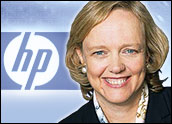
I was at Dell’s analyst conference last week and HP Discover is this week. As I was considering the contrast between the two companies, I started to think the contrast between Apple and HP is greater.
Given how many Apple employees used to work at HP before its massive layoffs, there is a lot of cross-pollination between the firms — and given how often Apple has embarrassed HP in the market, you’d think HP would have learned from its mistakes.
Apparently, it hasn’t. I’ll explain and then close with my product of the week: the amazing Nvidia Shield set-top box.
Making Turnarounds
I’ve been involved in and covered a lot of them. Most fail, but the turnaround that stands out is the one Steve Jobs accomplished at Apple. It was a simple process. Bring in a staff of subject matter experts, convince customers to ride out the change, cut the firm down to the basics, and then rebuild it.
When the iPod opportunity arose, Jobs was able to quickly pivot the newly loyal and lean firm to that opportunity, and Apple transformed from a company on death watch to the most valuable firm in the industry.
Looking back, while clearly not easy, the elements were a CEO who knew the segment, a loyal executive team that could execute, a onetime massive layoff/downsizing to make the company lean, and a strategy/vision that the company could rebuild around.
Let me add that the reason you do one deep layoff/downsizing is so the employees can be focused on executing and the future, rather than on whether they are going to be laid off.
So with Apple virtually next door to HP, you’d figure HP’s board would follow that relatively easy template.
Designing to Fail
For HP, a succession of boards started with people who didn’t know the company. The most successful was actually Mark Hurd who was a subject matter expert, and while he couldn’t seem to get out of cut mode, the firm actually appeared healthier under him than under Carly Fiorina or Meg Whitman — neither of whom came from a PC, server, or printer background.
In terms of setting strategy, Fiorina was better than Whitman — likely because Lucent was closer to HP than an early eBay.
In HP’s most recent turnaround attempt, there was no migration of Meg Whitman loyalists who knew the business, because she came from a very different business and had spent a considerable amount of time between roles. Both Whitman and Fiorina led with promises of great things to come, but neither could execute — and both, instead of cutting once deeply, implemented a series of layoffs that made it virtually impossible for the firm to execute.
Further, Whitman executed some kind of screwy executive rotation, placing executives in what almost seemed like random roles rather than matching their skills to their jobs. In short, Steve Jobs demonstrated a near-sure, easy way to effect a turnaround, but Whitman either didn’t see it or refused to follow Steve’s lead, assuming she knew better.
The end result is the mess you now see, a firm that appears out of control and rudderless in a market that is improving, largely because HP’s board couldn’t be bothered to find an executive who had the skills to run a company like HP.
Dell’s Addition
I mentioned I was at Dell’s analyst conference last week, and Michael Dell has added an interesting variant to Steve Jobs’ turnaround process. He added taking the company private, which removes the massive distractions that bombard a public company. That allowed the firm to enjoy most of the freedoms and lower costs of a pre-public company.
I actually think Apple would have done better had it also been able to do that, because it would have removed some of the SEC problems that became a distraction for Steve Jobs (and may have contributed to his getting cancer) and removed the issues Tim Cook now is having with Carl Icahn.
Wrapping Up: Lessons Learned
Given how painful layoffs and company failures are to investors, customers, and especially employees, it is important to know what makes the difference between a good and bad approach to a turnaround.
For success, you need strong competence at the top of the firm — ideally, that means the board, the CEO, and their direct reports. You need strong loyalty between the CEO and the executive staff. You need a company that can be put back into growth mode, so that critical human assets can be retained and people can focus on executing. You need a top-down strategy that the firm can follow that promises success. And, optionally, you want the firm to go private — all of which enables the firm to emerge like a phoenix reborn, as Apple and Dell have done.
This week a lot of my analyst peers are going to HP Discover. Most I’ve spoken to have indicated they are going to confirm their belief that HP is now beyond recovery. That is a sad end to a once-great company, given HP’s board only had to look at Apple to see how to get the turnaround job done.
Instead, most of the top executives are rumored to be looking for jobs, and many already have moved to firms like Oracle, which are benefiting from HP’s inability to follow Steve Jobs’ or Michael Dell’s leads.
Every once in a while, a company does something really interesting that could change or revolutionize a market. The Nvidia Shield set-top box could mark such a revolution.
Existing set-top boxes don’t do 4K well — or at all — and the existing game consoles have the same problem. Yet TV manufacturers are selling 4K TVs aggressively, which is creating a problem. because there really isn’t much 4K content. The content that does exist won’t stream to the TVs directly, even if they are smart TVs, because they weren’t designed to accept a 4K stream.
Oh, and the Blu-ray 4K systems and disks haven’t started shipping yet at affordable price levels. So you have TVs that can show 4K content, and you have some content, but you typically need a high-end PC tied to the TV to view it.
Well, the Shield set-top box (console) was designed to fit this need. At US$200, it is the most expensive product in its class, but it is also the only product from a major brand that will put 4K content onto your 4K TV.

Nvidia sent me one, and I’ve been testing it for most of the week. The only downside is that an Amazon Prime app hasn’t been delivered for this product yet — but other services, like Hulu and Netflix, are available. Since this is an Android TV product, Google content is available as well.
Like Amazon Fire TV, which I also have, this console will play games — but unlike Fire, this product will play streamed games off the Nvidia Grid service, and these games are console class.
The end result is arguably the best set-top box for a 4K TV currently in the market, and the best implementation of Android TV. The Nvidia Shield set-top box is amazing, so it is my product of the week.
























































hi Rob,
Good read. I think HP is a lost leader. Called it after Hurd was let go..and HP is not getting better..
BUT, you lost me here:
I actually think Apple would have done better had it also been able to do that, because it would have removed some of the SEC problems that became a distraction for Steve Jobs (and may have contributed to his getting cancer) and removed the issues Tim Cook now is having with Carl Icahn.
You made valid points regarding HP’s continued missteps. You made a good point regarding Michael Dell’s position regarding public vrs private, and the ability to be agile and focused as a private company but to state being public may have led to SJ’s cancer is uncalled for. Was there patchouli burning in your study while you wrote this!! 🙂
Look forward to your next article.
Mark